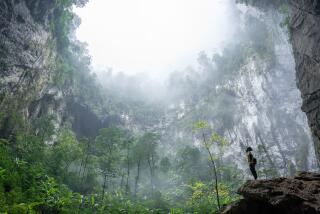1,600-Year-Old Cave Frescoes Have Survived War, Quakes, Vandals : Human Breathing Threatens Ancient Chinese Murals
- Share via
DUNHUANG, China — The honeycomb of Buddhist caves near here has survived wars, earthquakes, sandstorms and vandalism for 1,600 years. But the precious murals that are its main treasure are now threatened by something else--human breath.
Hundreds of caves are carved into a cliff about three hours by camel from the Dunhuang oasis in northern China. They are one of the wonders of the world, a storehouse of art and information about the fabled Silk Road at the height of its prosperity a millennium and more ago.
Many of Dunhuang’s treasures are now to be found in museums in West Europe and Japan. A secret cave containing 50,000 scrolls, paintings and manuscripts that had been sealed up for nearly 1,000 years ago was discovered in 1900. But foreign adventurers combing the old Silk Road for artifacts quickly snapped up the lion’s share.
The caves and the ancient Buddhist murals and statues they contain have begun to attract large numbers of people since they were opened to the public in 1980.
‘Very Serious Effect’
“Visitors are having a very serious effect on the state of the murals from their breathing, from the humidity they bring into the caves and from their clothing brushing against the walls,” Dunhuang official Ma Jingchi said. “What has preserved them over the centuries is the dryness, the darkness and the free movement of air through the caves.
“But with the arrival of so many people, the conditions which have made it possible for them to survive are under threat.”
Ma said there had been a marked loss of detail in many of the frescoes over the last 40 years because of humidity and light. “This is a problem, and we are looking at ways to deal with it,” he said.
The number of visitors to the caves reached 110,000 last year, up from a handful in 1980, and there are plans for further big increases in the next few years.
Limits to Visits
“Our basic plan is to limit the number of people who come into the caves,” Ma said. “We plan to eventually build a museum opposite the caves which would include full copies of a number of the caves, complete with statues and murals. People could view them and then perhaps move in to look at the real caves for a very short period of time.”
Dunhuang was a stopover on the ancient Silk Road, which spanned Central Asia. It sent silk and spices to the West and brought Buddhism from India to China.
Work on carving out the cave shrines to Buddha was started in AD 366. The oldest of the 492 caves now open dates from the 5th Century.
Richly Detailed Frescoes
Many of the caves and most of the best murals and statues were created in the 7th and 8th centuries, when the Tang Dynasty was at the height of its power.
The frescoes, painted by an army of devout but anonymous craftsmen, are immensely rich in detail. They depict stories from Buddhist scriptures and scenes of life in China and the Silk Road oases.
The blues and greens have retained their original color. But light seeping into the caves has made reds and flesh tones turn black. Camera flashes have speeded up the process, and all photography is now banned inside the caves.
Worship by Buddhists is now forbidden in all but one cave, which has a 100-foot high Buddha but no murals that could be harmed by the smoke of incense.
Some Caves Vandalized
Some of the caves have suffered serious vandalism over the last few decades. White Russian soldiers passing through northwest China after the 1917 Russian Revolution stayed inside the caves, and many left their names carved in the ancient frescoes alongside the graffiti left by Chinese visitors.
In a number of caves there are square holes on the murals, which mark the sections acquired by American archeologist Langdon Warner in the 1920s. Officials at Dunhuang do not hide their loathing for the way they believe Warner mutilated the murals.
“What he did was barbarous and we hate him,” director Duan Wenjie said.
More to Read
Sign up for Essential California
The most important California stories and recommendations in your inbox every morning.
You may occasionally receive promotional content from the Los Angeles Times.













